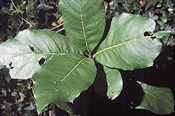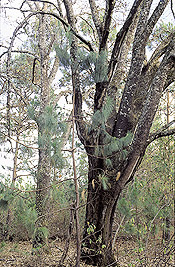Introduction
A deciduous small tree that grows up to 15 m in height and occurs in sub-montane to montane dry forest in Mexico. It has a dark bark and is characterized by bright red foliage in early spring.
Why is this species important?
This species represents one of the Quercus species considered of great importance in Mexico. Habitat of Q. hintonii has been seriously destroyed and reduced, undermining the viability of the species. Q. hintonii wood has a variety of local uses, being part of the traditional culture of Tejupilco people.
Where is it found?
Q. hintonii is endemic to Mexico, occurring in the south-east of Mexico State between 1300 and 2000 m. A recent study by the Sir Harold Hillier Gardens and Arboretum together with the University of Puebla has determined that this species covers just 46 000 hectares, distributed across three highly disturbed populations.
How do people use it?
Q. hintonii wood is used locally for tool handles, beams and fencing poles, but primarily for firewood. The wood is traditionally used to bake "las finas" bread, the characteristic taste of which is imparted by the smoke.
Why is it threatened?
The populations of Q. hintonii have been dramatically reduced as a result of habitat loss to the point where the species is considered in danger of extinction. Agriculture (maize and fruit trees), coffee plantation and road construction have all contributed to the decline in populations. The species has also been highly affected by grazing, which prevents regeneration.
What conservation action is needed?
The recent study as part of the Global Trees Campaign revealed that the current status of Q. hintonii population is strongly associated with the development and economic activities of the local communities. Conservation measures include the involvement of local authorities and landowners, training on plant propagation, field research, and the development of an education campaign.Collaborative research between Mexican experts from the University of Puebla and staff from the Sir Harold Hillier Gardens & Arboretum in the UK has led to the development of a conservation strategy for Quercus hintonii, which was presented to the Regional Education Co-ordinator, the presidents of municipalities and the authorities in charge of reforestation. In addition, an educational guide to the conservation of the species has been produced and an agreement has been reached to provide local training in oak propagation techniques.
For more information, please see the project pages here.
Selected references
Acosta, M., Coombes, A. 2000. Estrategia de Conservacion de Quercus hintonii. Reporte final. Fauna & Flora Internacional. Referencia 99429.
Located at Herbario y Jardin Botanico VIEP-BUAP; The Sir Harold Hillier Gardens and Arboretum; Jardin Botanico Louise Wardle de Camacho, Africam, S.A.; Asociacion Mexicana de Jardines Botanicos, A. C. ; Reserva Fundacion Xochitla, A.C.; Comision Estatal de Parques Naturales y de la Fauna del Estado de Mexico; Instituto de Ecologia, SEMARNAP. Puebla, Mexico.
|
 |


|